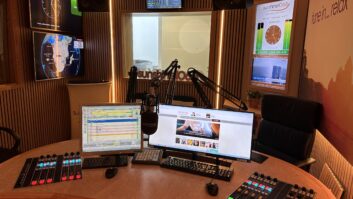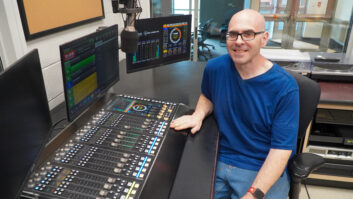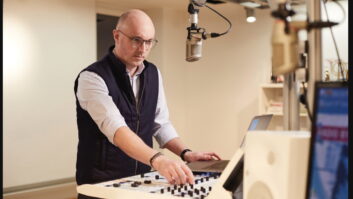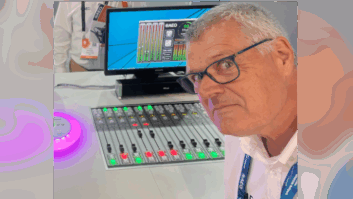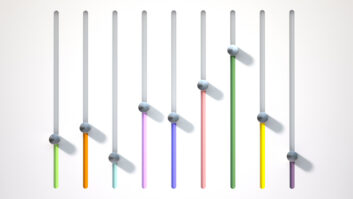
N.Y. State Senator Thomas Libous (left) and N.Y. State Assemblyman Gary Finch inside WEBO’s temporary studio in the aftermath of Tropical Storm Lee. The small Alesis MultiMix 8 USB at the bottom of the picture was the go-to mixer for this broadcast. In the past few years, I’ve seen fewer and fewer (if any) mixers in the field in most ad hoc news situations. The prevalence of laptop/netbook/smartphone audio editing programs and increased availability of mobile broadband and other Internet portals makes the mechanics of editing, producing and transmitting a ready-for-air news report as simple as a click of the keys.
However, when those reports turn into live originations, as they sometimes do, you need more audio inputs than the single jack on the laptop and smartphone, and you need the ability to mix those multiple inputs in real time. That’s why a small mixer should be in the inventory of every news department or radio engineer’s emergency kit.
For this column, I’m defining a small mixer as a device that will mix at least two-to-12 microphone and line-level audio sources. It can be powered by line or battery power. When I came into the business back in the late ’60s, the utilitarian Shure M67 mixer was the standard, and it is still being used today.
Interface
I have a low serial number JK Audio RemoteMix Sport which I’ll take with me if I need to mix two mics and audio. It can feed a dial-up phone line (RJ-11), a handset interface and, with the right connecting cords, a cellphone, codec or broadcast loop. The unit has a built-in phone line limiter and runs on both AC line and 9 volt battery power. My older unit uses a Daptor Three to interface with Bluetooth applications. The newest version RemoteMix 3.5 has built-in interfaces for a cellphone (wired), and for connection via phone-grade Bluetooth, as well as the legacy RJ-11, handset and codec connection capability.
Codecs from manufacturers such as Comrex, Tieline, AEQ and others have built-in mixing capability to keep the loads light but versatile. So, too, are the two-input (mic and line) dedicated cellphone interfaces like the Conex Flip Jack and the JK Audio RemoteMix One. See my review of the RemoteMix One in the Nov. 7, 2012 issue of Radio World.
All of those will help your news people and broadcasters in the field produce reports and programming with audio quality that complements the production values of those reports.

The WEBO on-air and engineering teams work from the station’s emergency remote on-air studio (a borrowed RV) during the aftermath of flooding from Lee in September 2011. But when water is running over the door sills to your newsroom/studio, and your station needs to get back on the air to provide information that can save lives, you need options — and fast. That’s how a small mixer — an Alesis MultiMix 8 USB in this instance — helped the listeners of WEBO(AM/FM) in Owego, N.Y., hear that information, during the aftermath of Tropical Storm Lee last year.
WEBO’s President and General Manager Dave Radigan had to evacuate the main studio location and equipment, and at the same time re-establish operations from the station’s transmitter site in a recreational vehicle. “Our survival instincts kicked in. We were smart to grab whatever equipment we could when we evacuated,” he says of the event.
The MultiMix 8 USB, with three handheld microphones, was hardwired into the AM audio processor, and its audio traveled on a twisted copper pair to a junction box on a telephone pole at the transmitter site. An unused underground wire pair carried the audio into the transmitter building, and was hardwired into the transmitter’s audio input. Radigan said, “No audio connectors were used; none were available, other than the XLR coming out of the processor. From there, it was copper pair wire, twisted together enough times to keep them (the pairs) from coming apart, and in some cases, covered with electrical tape.”
This primitive setup would allow WEBO to broadcast information released by public safety officials, and reports with information from amateur radio operators who themselves set up temporary operations at the high ground of the transmitter site.
Village, town, county and state elected officials used WEBO to reach out to people in the area. After the flood, when the local weekly and daily newspapers couldn’t publish or gather news because of the flooding, businesses relied on WEBO commercials to let the people in Owego know which stores were open and where to get supplies.
The constant in this business is that nothing is constant, and your normal everyday operations can be disrupted in seconds. Backup plans are best formulated before they need to be executed; operators and (where still active) news departments do need backup equipment like those small mixers available.
Equipment in a backup kit does not have to be new stock. Reconditioned items can work well, once tested for operational reliability, and keep the project under a budget. Once a backup kit is assembled, managers, engineers and news people must resist the temptation to cannibalize the kit for other uses.
While we don’t need the capability to mix a live band on a news job, the small mixer — whether built-in or standalone — can help us tell our stories a bit more easily. Spending less time on the mechanics of the production and transmission means we can spend more time on producing the compelling content our listeners and advertisers appreciate and expect — whether that content is produced under “routine” or emergency situations.
Do you have a topic or question you’d like to see mentioned in a future Radio Road Warrior Column? Our editors always welcome suggestions ([email protected]) as do I at [email protected].You can even tweet them to me (Twitter.com/MSRnet).
Paul Kaminski is news director for the Motor Sports Radio Network, a contributor and freelance reporter for CBS News, Radio and since 1997, a contributor and columnist for Radio World.

